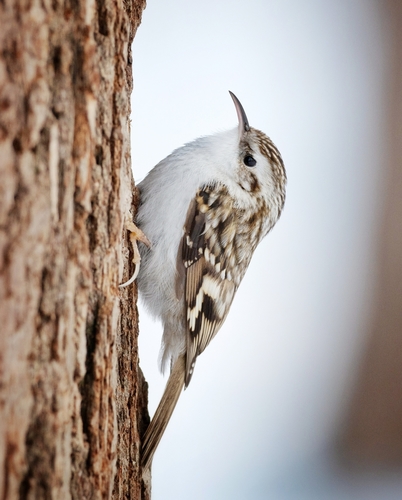
Eurasian Treecreeper
The Eurasian Treecreeper (*Certhia familiaris*) is a small, cryptic passerine bird found throughout the temperate and subarctic regions of Eurasia. It plays a vital ecological role as an insectivore, controlling populations of forest invertebrates. Known for its unique foraging behavior of spiraling up tree trunks, it is well-adapted to a life spent searching for insects and spiders in bark crevices. While not globally threatened, it is an indicator species for the health of mature woodlands. There is no significant cultural significance attributed to this species.
12-14 cm
Length
17-21 cm
Wingspan
Least Concern
Conservation Status
Distribution
Widespread across Europe and Asia, from the British Isles and the Iberian Peninsula eastward to Japan. Its range extends north into Scandinavia and Siberia, and south to the Mediterranean region, the Himalayas, and parts of China. It is generally non-migratory, though some northern populations may undertake short-distance movements in winter.
Lifespan
Typically 2-3 years in the wild, but up to 7 years has been recorded.
Eurasian Treecreeper's Habitat
Habitat Types
Mature deciduous forests, Mixed coniferous forests, Parks with old trees, Wooded gardens
Climate Zones
Temperate, Boreal, Subarctic
Adaptations
Their stiffened tail feathers provide support while climbing vertically. Cryptic plumage provides excellent camouflage against tree bark. Strong, curved claws help them grip onto the bark.
Variations
Numerous subspecies are recognized (around 9), differing subtly in plumage coloration and size across their extensive geographic range. For example, birds in the British Isles (*C. f. britannica*) tend to be darker and more rufous than those in continental Europe (*C. f. familiaris*).
Appearance
Breeding Plumage
Little difference between breeding and non-breeding plumage.
Seasonal Feather Changes
Minimal seasonal variation.
Sex Based Plumage Differences
Males and females have very similar plumage.
Notable Features
Streaked brown upperparts providing camouflage., White underparts., Long, decurved bill., Stiff tail feathers used for support.
Diet and Feeding
Primary Foods
Insects, Spiders, Insect larvae, Small invertebrates
Foraging Behavior
Characteristically creeps upwards on tree trunks and branches, probing bark crevices with its long, curved bill. It typically starts at the base of a tree and spirals upwards, often flying to the base of another tree after reaching the top.
Specializations
The long, decurved bill is perfectly adapted for extracting prey from bark crevices. Stiff tail feathers provide support while climbing.
Seasonal Diet Variations
In winter, when insects are less abundant, they may consume more seeds and may visit bird feeders, particularly for suet.
Behavior
Social Structure
Generally solitary or in pairs during the breeding season. May form small, loose flocks in winter, sometimes joining mixed-species foraging flocks.
Communication
High-pitched 'tsee' calls., A trilling song used for territorial defense and mate attraction.
Migration
Mostly resident, but some northern populations may undertake short-distance altitudinal or southward movements in winter.
Territorial or Group Behaviors
Territorial during the breeding season, defending a small area around the nest. Otherwise, relatively non-territorial.
Conservation
Threats
Habitat loss due to deforestation and woodland management practices., Loss of mature trees., Pesticide use reducing invertebrate prey availability.
Protection Programs
General habitat conservation measures., Promotion of sustainable forestry practices., Provision of nest boxes in some areas.
Local National Laws
Protected under various national and international wildlife protection laws, such as the EU Birds Directive.
Population Trend
Stable
Population Estimates
The global population is estimated to be between 45,000,000 and 150,000,000 individuals.
Interesting Facts
They almost always climb upwards, rarely descending headfirst.
This is due to the structure of their feet and tail, which are adapted for upward movement.
They can 'freeze' against the bark when threatened, relying on their camouflage for protection.
Their cryptic plumage makes them very difficult to see against tree bark.
They often roost in small crevices or behind loose bark, sometimes huddling together for warmth in winter.
This helps them conserve energy during cold nights.
Faqs about Eurasian Treecreeper
What is the difference between a Eurasian Treecreeper and a Nuthatch?
Nuthatches can climb up and down trees headfirst, while Treecreepers always climb upwards. Nuthatches also have a different body shape and bill.
Do Eurasian Treecreepers migrate?
Most Eurasian Treecreepers are resident, but some northern populations may move short distances south or to lower altitudes in winter.
What do Eurasian Treecreepers eat?
They primarily eat insects, spiders, and other small invertebrates found in tree bark. They may also eat some seeds in winter.
Copyright @ Nature Style Limited. All Rights Reserved.
 English
English